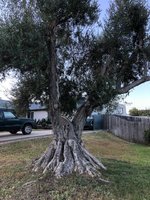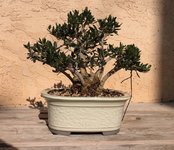Juanmi
Mame
Also, I'd be curious to take a look to the tree we're talking about to see if we can figure out what makes it look unnatural. (If it really does)







Would love to spend an afternoon in that garden. Wow! Thx.Tom Vuong (SoCal)
One of those I have too!I don't have any current pics of old olives growing on the edges of fields or in old abandoned plantings in California, but here are a couple landscape examples of the two basic shapes I most often see.
Multi trunk is most common. As Bonsai Nut and Juanmi said, they tend to sucker like crazy and spread outward. If they aren't minimally maintained (suckers removed at least once a year) they do tend to look like shrubs. These have been cleaned of suckers, but mostly left natural.
View attachment 561134View attachment 561135
Hourglass shape. Single trunk trees seem to develop a massive conical trunk and a multi-branch canopy. Here's one old tree, and a younger specimen beginning to develop the same look.
View attachment 561136View attachment 561137
As a teenager, I dug up a wild olive seedling out of the yard, stuck it in a pot in the shade, and literally forgot about it in my parents' yard for 25 years until I got into bonsai. It developed a mini version of the same burl trunk I see in bigger trees, with four spindly branches coming off of it. I began caring for it and encouraged more branches to grow from the burl. I'm currently working of ramifying it as a shohin.
View attachment 561143
View attachment 561146

That's a beautiful tree!Thx. In the end I decided to continue on the original path, a traditional olive bonsai style..
View attachment 561160
Gosh, then the tree will look just like a plain old bonsai!Thx. In the end I decided to continue on the original path, a traditional olive bonsai style..
exactlyGosh, then the tree will look just like a plain old bonsai!
Cheers
DSD sends
I think it is however a fair comment. IF we take inspiration from Nature, we might as well keep in the back of our mind how the species would look as an aged, mature natually grown specimen, and take guide from that. I strive to -also- have tree where just from the branching and style people see immediatly which species it it. Yes, one can style an oak as a pine, but why would you?This natural thought process...makes me pause. We tend to have a hand with such things with bonsai...why one would make a comment such as that.
Truly...I can't say I've seen amazing wild olive. Truth be told. I do have naturalistic trees on my bench. But...I think that there are no grand old olives shared...says a lot. Wouldn't you? That they aren't all that impressive. Or we could find them shared. That's where my gerbil lands.I think it is however a fair comment. IF we take inspiration from Nature, we might as well keep in the back of our mind how the species would look as an aged, mature natually grown specimen, and take guide from that. I strive to -also- have tree where just from the branching and style people see immediatly which species it it. Yes, one can style an oak as a pine, but why would you?
So hence the question... How DO natural aged olives look. I have no clue! Gladly, from this thread I glace that may have dificulty finding great examples of unpruned centrury old olives in the wild.I feel les stupid for not being able to figure it out.
Head tilt...as I do when I concentrate. I think you're going in the right direction for the trunk. Truth be told. Nice taper there.Thx. In the end I decided to continue on the original path, a traditional olive bonsai style..
View attachment 561160
